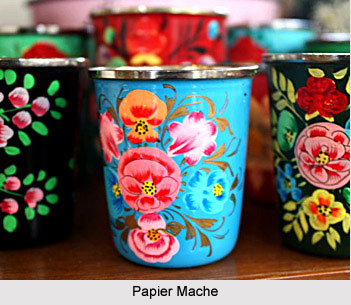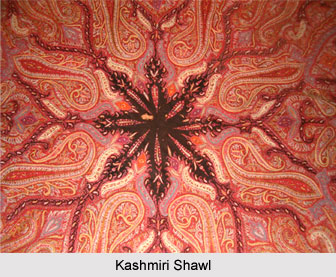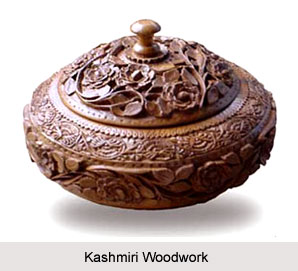 Art of Kashmir is a fascinating display of a number of beautiful creations. The various art forms of the state have been considerably influenced by the various cultures that they have interacted with, and the outcome has been a beautiful rendering of these various cultural influences.
Art of Kashmir is a fascinating display of a number of beautiful creations. The various art forms of the state have been considerably influenced by the various cultures that they have interacted with, and the outcome has been a beautiful rendering of these various cultural influences.
Persian Influence on Kashmiri Art
The influence of Islamic art from the directions of north and south is responsible for the development of the many industries for which Kashmir is famous, e.g. shawl, carpet, Papier Mache, wood-carving, etc. Zain-ul-Abidin is mainly responsible for the introduction of these arts from Samarqand and Bukhara, which were the centres of Islamic civilization then. The Persian language and literature, first introduced into Kashmir by Zain-ul-Abidin, further enriched the cultural treasures of Kashmir resulting in a synthesis of the Hindu and Muslim civilizations. Kashmiris attained a great proficiency in the new language and literature and produced eminent poets and scholars like Ghani, Sarfi, Fani etc. In the development of Kashmiri painting, architecture, music and poetry, Muslims played a prominent part. The Hari Parbat fort and the bastion wall, the Jumma and Pathar Masjids, Pari Mahal and world-famous Mughal Gardens are living testimonies to the outstanding contribution of Islam to the art and thought of the Kashmiris.
The various handicrafts produced in Kashmir, such as carpets, shawls, Papier Mache etc are known throughout the world for their grandeur and artistic work. The many beautiful crafts created here are in keeping with the grand old civilisation of the state, and the art has been perfected over centuries. The various designs and naqqashi work which is done on the handicraft items has a strong link to the ancient tradition. The varied cultural and ethnic composition of the population has enabled a great variety of arts and crafts, techniques and motifs to flourish in this land.
 Among the handicrafts, Kashmiri woodwork is very popular. Beautiful and intricate carving can be seen done on a number of items such as furniture, wooden boxes and decorative items. Another equally popular art form is the Kashmiri Papier Mache work. These include Papier-Mache vases, bowls and other decorative items with exquisite traditional designs in vibrant colors on them. Hand woven willow baskets are also very common in Kashmir. It is utilized by the locals for their daily use.
Among the handicrafts, Kashmiri woodwork is very popular. Beautiful and intricate carving can be seen done on a number of items such as furniture, wooden boxes and decorative items. Another equally popular art form is the Kashmiri Papier Mache work. These include Papier-Mache vases, bowls and other decorative items with exquisite traditional designs in vibrant colors on them. Hand woven willow baskets are also very common in Kashmir. It is utilized by the locals for their daily use.
Kashmiri shawls and carpets are a particular speciality of the state. The silk and woolen items have intricate designs on them as do the various wall hangings. The wall hangings with Naqqashi work are a particular favourite. The Jamavar work that is done by artisans on silk and woolen shawls is characteristic of the state of Kashmir.
In the field of the performing arts too Kashmir shines brightly. From ancient times Kashmir has been the centre of art, literature and scholarship. In the field of the dramatic arts, the history goes back a long way. It began with the performance by Baands, who moved from house to house, entertaining people by dance and song, on good occasions. There were a number of such dramatic performances seen in the state, such as Raslila, Pather etc which developed down the ages. By and by many plays, skits, shadow plays and operas were written by Mr. D.N. Nadim, Akhtar Mohiudin Amin Kamil, and Roshan.
 Music in Kashmiri language is called Sufiana Kalam. It is difficult to guess how and when it originated because Kashmiri music shows elements of Indian and Iranian music. After the advent of Islam, Kashmiri music may have been influenced by Iranian music. The musical instruments used in Kashmiri music are the Santoor, Nagara, Dukra and Sitar. Popular music in Kashmir includes the Rabab, the unique Bakhan songs which are hummed without the aid of any musical instrument and Geetru which is performed during fairs and festivals and is a combination of song and dance routine. Among the dance forms in Kashmir, apart for the immensely popular Geetru is the Rouff, which is a conventional dance performed by the women of the Kashmir region. The Dumhal is an illustrious dance form of Kashmir. The men of the Wattal region are experts in performing it. A special theatrical art form has been created inter-mingling both marriage song and dance. It is a part of marriage celebration, which is observed at the time period followed after the departure of men of the groom`s residence along with the couple. Fun, gossip and various incidents of nuptial nights are done creating an ambience of amusement and jubilance. Hafiz Nagma is grounded on the classical music of Kashmir- the Sufiana Kalam. The danseuse is called `Hafiza`. The salient instrument employed in Hafiz Nagma is called Santoor. Songs of Habab Khatun too are composed depicting the sadness of the famous Kashmiri princess of the same name. She was sad as she had been separated from her beloved husband Yousuf King.
Music in Kashmiri language is called Sufiana Kalam. It is difficult to guess how and when it originated because Kashmiri music shows elements of Indian and Iranian music. After the advent of Islam, Kashmiri music may have been influenced by Iranian music. The musical instruments used in Kashmiri music are the Santoor, Nagara, Dukra and Sitar. Popular music in Kashmir includes the Rabab, the unique Bakhan songs which are hummed without the aid of any musical instrument and Geetru which is performed during fairs and festivals and is a combination of song and dance routine. Among the dance forms in Kashmir, apart for the immensely popular Geetru is the Rouff, which is a conventional dance performed by the women of the Kashmir region. The Dumhal is an illustrious dance form of Kashmir. The men of the Wattal region are experts in performing it. A special theatrical art form has been created inter-mingling both marriage song and dance. It is a part of marriage celebration, which is observed at the time period followed after the departure of men of the groom`s residence along with the couple. Fun, gossip and various incidents of nuptial nights are done creating an ambience of amusement and jubilance. Hafiz Nagma is grounded on the classical music of Kashmir- the Sufiana Kalam. The danseuse is called `Hafiza`. The salient instrument employed in Hafiz Nagma is called Santoor. Songs of Habab Khatun too are composed depicting the sadness of the famous Kashmiri princess of the same name. She was sad as she had been separated from her beloved husband Yousuf King.
Folksongs of Kashmir are as rich in content, theme and form as any other. Songs known in Kashmir as "Shaar" are compiled on any subject. These songs are the natural and original expression of the people`s soul, its companion in joy and sorrow. All sorts of incidents provide inspiration for the rustic muse. There are dancing songs set for different seasons and occasions of the year and mystical brief verse. There are songs sung in chorus at harvest time, there are songs sung in winter around a bubbling Hukka and a boiling Samovar. There are many songs which make Kashmiris spend nights together in singing ballads, such as the marriage of Lord Shiva or Krishna Avatar. These folk songs have beauty, appeal, entertainment melody and richness.
Thus, the art of Kashmir is an exciting mix of the traditions of Kashmir being followed down the ages as well as the incorporation of various other cultural that have been incorporated along the way.






